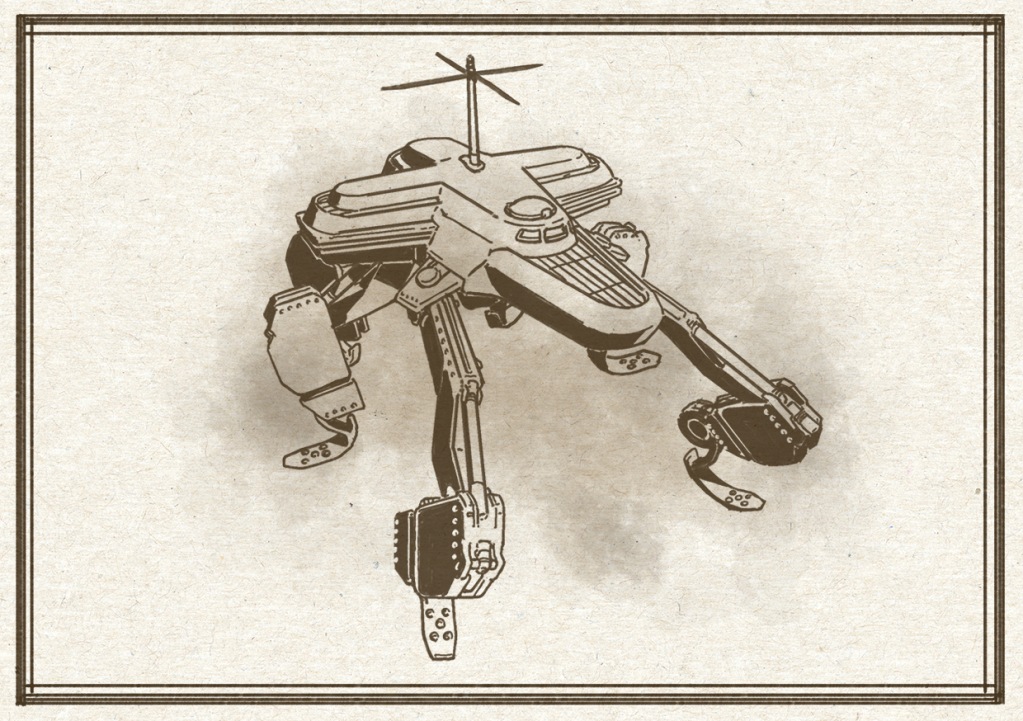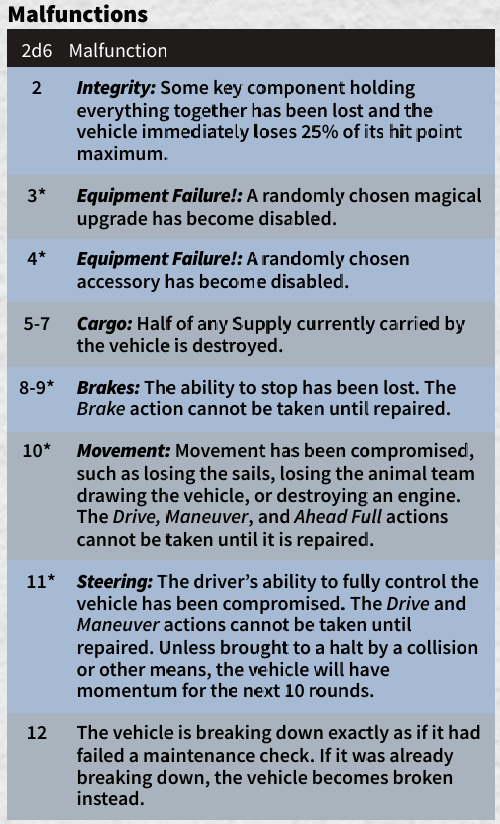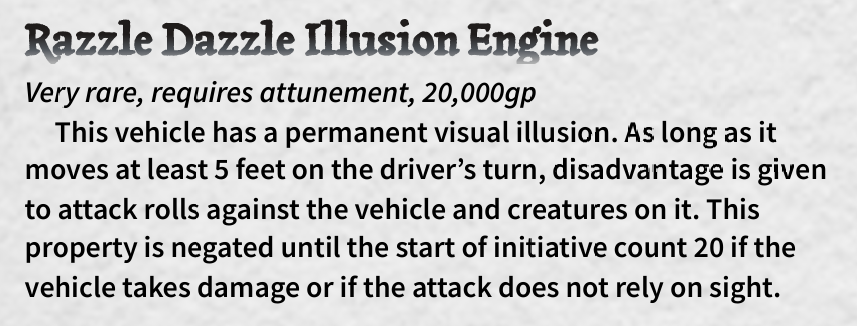
When PJ Coffey from Homebrew and Hacking asked me if I wanted a review copy of one of their books, I knew I wanted to take a look at One if by Land, Two if by Sea, Three if by Air. This cool 5e vehicle sourcebook packs in more than 30 vehicles and variants, along with modifications and malfunctions, chase rules, and more.
I’ve always loved vehicles in RPGs, even long before I discovered Dungeons and Dragons. I remember unlocking the airship in the original Final Fantasy for NES and thinking it was the coolest thing ever.
Although written with Level Up: Advanced 5th Edition in mind (the book does reference some A5E sourcebooks occasionally), from what I can tell, the book is fully compatible with core Dungeons and Dragons 5th edition rules.
Quirky Anachronistic Style
One if by Land, Two if by Sea, Three if by Air has a unique style that makes it stand out from the typical 5e vehicle sourcebook. I mean, just check that amazing cover art!
The majority of the illustrations seem to harken to an early to mid 1900s style.
The illustration for an automobile, for example, is a Ford Model A, while the illustration for a motorcycle is reminiscent of 1940s military bikes used in World War II. Other illustrations, like the airspeeder and mechapod are obviously more inclined towards a futuristic science fiction setting.
In particular, the book seems to intentionally veer from the medieval fantasy setting of most Dungeons and Dragons games.
I don’t think this is necessarily a problem — the stat blocks themselves can be easily integrated into any setting. Even the mechapod uses standard cannon statistics for its armament.
I could see some tinkering gnomes cobbling together an airspeeder and making it part of a fun adventure in a medieval fantasy setting.
Clean, Crisp Art

Throughout the book are some really beautiful vehicle illustrations by Alex Connolly. Black and white illustrations of ornithopters, submersibles, covered wagons, and dogsleds adorn the book’s pages.
The only full-color illustration is on the cover, three stacked scenes of Ford Model As chasing down a chimera, a kraken approaching a galleon, and biplanes dogfighting with dragons. It’s a perfect piece of cover art that really conveys the style of the book.
This is nitpicky as hell, but there are a couple of places in the book where the art is cut off by the page margin. I would have preferred to see the art scaled down just a tad so we could the entire illustration, but that’s just me.
I also wish we could have seen a couple of small illustrations for the Magical Upgrades section of the book. It’d be nice to know what an “Existence Dealignment Cascade Engine” looks like, for example.
The art as a whole is a great addition to the book. The choice of black and white illustrations reminds me of early TTRPG books, which I really enjoy.
Now that we’ve talked about first impressions, let’s dig into the rules themselves:
Simple, Easy To Use 5e Vehicle Rules
The vehicle rules in One if by Land, Two if by Sea, Three if by Air are simple and easy to approach. They aren’t quite so complex as the rules I’ve encountered in other 5e vehicle sourcebooks.
Statblocks for vehicles are smaller than most creatures, tracking attributes such as number of drivers and passengers, HP, AC, carrying capacity, repair DC, and the amount of damage the vehicle deals if it collides with something.
Vehicles have Special Feature keywords such as Armed (the vehicle is equipped with siege weapons), or Stall (if the vehicle doesn’t have momentum or doesn’t move during its turn, it falls 500ft).
I do think the section on Driving Vehicles could have benefitted from a diagram or two, as it took me a couple read-throughs to get a grasp on how turning vehicles works:
All vehicles have a direction they are “facing”, which
determines the direction of travel for movement. This is
typically the “front” of the vehicle. When the vehicle turns,
draw an imaginary line perpendicular to the front of the vehicle
directly from the “rear.” The point on the rear of the vehicle
where this imaginary line meets the end of the vehicle remains
static and the front of the vehicle is moved through the desired
number of degrees up to the maximum allowed.
I thought the rule on vehicle Momentum was particular elegant:
A vehicle has momentum or it does not. If it has momentum,
on initiative count 20, all vehicles with momentum move
half their movement speed directly forward. Momentum
ends automatically after 1 minute (10 rounds) if no vehicle
actions that would grant a vehicle momentum are taken.
Vehicle momentum is something that often gets overlooked in 5e vehicle sourcebooks, and these rules allow for really evocative scenes like “what happens when the galleon is on a collision course with the canoe?” or “Oh no, the locomotive is speeding towards the damaged railroad bridge!”
Malfunctions, Stunts and Chases

One if by Land, Two if by Sea, Three if by Air really starts to shine on page 5, when we start learning about the rules for Malfunctions, and what happens when vehicles are damaged or destroyed.
The Malfunctions table (see above) is really cool, and includes events like the vehicle losing the ability to brake or steer, or some of the vehicle’s cargo being damaged or destroyed.
There’s even a section on rules for Salvaging destroyed vehicles.
Page 9 dives into Dramatic Stunts, which are meaningful options for players to influence vehicle scenes, such as spitting fuel directly into a vehicle’s engine intake, quick fixing a malfunction, or plotting evasion action through a field of obstacles.

There’s even a rule for making Charisma checks to provide bonuses to NPC crewmembers.
Theatre of the Mind Chase Rules
One if by Land, Two if by Sea, Three if by Air includes some great rules for managing chase scenes if you aren’t using a combat grid, by simply assigning chase participants to a range — Close, Medium, Long, and Extreme.
The chase rules allow for actions like the chased vehicle creating obstacles for pursuers, or classic cinematic scenes like ditching cargo or equipment to lighten the load and increase your vehicle’s speed to catch up to a fleeing vehicle.
Magical Upgrades Are A Bargain
Look, it wouldn’t be a 5th edition game if it didn’t have some magic, right? The chapter on Customizing Vehicles includes both mundane and magical upgrades.
Mundane upgrades, called Vehicle Accessories, range from Camouflage or added Airlocks to a Glass Bottom that increases Perception at the cost of AC.
Additional armor or mantlets can be added to vehicles too, increasing AC (but decreasing speed) or adding barriers that provide cover for crew onboard.
Things get really cool when we get into the Magical Upgrades, which include options like a one-time use item that surrounds the vehicle with a resilient sphere for 1 minute or emergency crew members in the form of unseen servants.
These upgrades all have fun evocative names, like my favorite, the “Razzle Dazzle Illusion Engine.”

Are the prices too cheap?
My only complaint with this section is that some of the prices feel a little low. 5 gold for an expertise die to add to Stealth checks from Camouflage is a pittance at the point where parties are likely to get access to a vehicle (especially considering many vehicles cost 10,000 gold or more).
Pricing for the Magical Upgrades seem to follow the guidelines for Magic Item Prices by Rarity from the Dungeon Master’s Guide, but I’m not sure these rules translate well into pricing for vehicle upgrades.
Those rules are designed for a magic item owned by a single individual. I think it’s reasonable to assume that 4-5 party members may all be investing a portion of their wealth into tricking out a party vehicle, so I’m comfortable with doubling or even tripling the prices suggested by the book.
The Vehicles Themselves

The rest of the book consists of the actual statblocks for vehicles.
This section more than triples the number of vehicles offered in the DMG, with a further sixteen of the vehicles including variants that trade out of some of the vehicle’s Special Features.
The statblocks are small and easy to read, which I really enjoy. Since vehicles don’t have Actions on their own, their statblocks can be pretty minimalist. This allows the vehicles to become a set piece or element of the adventure without overshadowing the characters and creatures that are piloting them.
Finally, the book ends with a Vehicle Character Sheet for keep track of your vehicle’s Special Features, Modifications, Malfunctions, etc.
Should You Get This 5e Vehicle Sourcebook?
P.J. Coffey and Adam Donovan have crafted a really great book. Although only 44 pages, One if by Land, Two if by Sea, Three if by Air packs a lot into its page count. I really enjoyed the balance of rules and resources.
If you use a lot of vehicles in your game, or want to give your players a unique reward in the form of cool, customized vehicle, this book would be a really great addition to your TTRPG library.
That said, it’s one of those books that may only be useful to you if your setting includes anachronistic vehicles. If the majority of your world uses horse-drawn carts, most of what this book offers will probably be overkill for you.
The PDF copy is $10.00 USD, but right now the print + PDF bundle is just $15.00, so do yourself a favor and grab the bundle.
There’s also a free 8th-level adventure, Dragons vs. Biplanes, which ties into the rules presented in this book. You can grab it here.
More from Homebrew and Hacking
- Follow P.J. Coffey on Bluesky.
- P.J. Coffey and I have recently been working together on a Bluesky TTRPG Starter Packs Directory.
- Homebrew and Hacking also has an upcoming Backerkit project: Crafting Heritages, Cultures, and More: Worldbuilding. Hit the link to get notified when the Backerkit campaign goes live!
- Homebrew and Hacking also has a great selection of products on DriveThruRPG, including a free System Resource Document that serves as a great preview of their products. Grab the Homebrew and Hacking SRD here.
